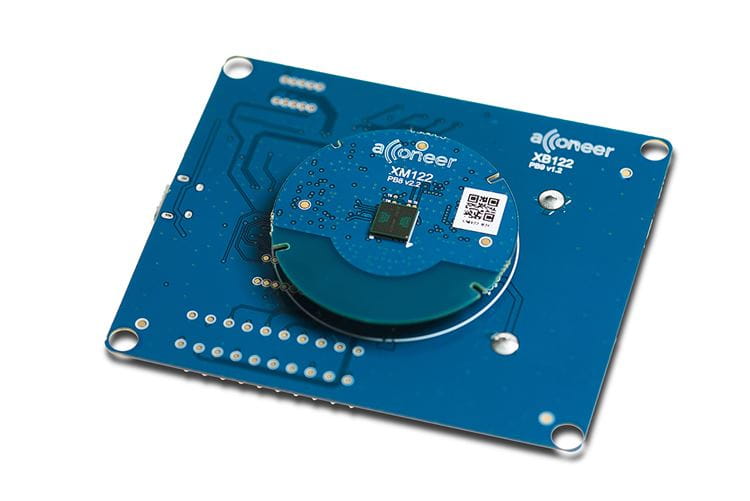Nordic Semiconductor today announces that Lund, Sweden-based Acconeer, a developer of high tech sensor-based solutions, has selected Nordic’s nRF52840 Bluetooth® 5.2/Bluetooth Low Energy (Bluetooth LE) advanced multiprotocol System-on-Chip (SoC) to power its ‘XM122 IoT Module’.
The module combines the Nordic SoC with the ‘A111 Pulsed Coherent Radar’, enabling millimeter-level radar distance ranging and presence detection in a wide range of applications, such as tank level or waste bin measurements, gesture detection, or parking lot capacity sensing.
The XM122 IoT module was developed as a reference module that can be used to support developers in their designs for commercial use, as well as for evaluation and development purposes when used in conjunction with the company’s ‘XB122 Breakout Board’. Acconeer has also collaborated with Imagimob, an Edge AI company, to produce a gesture-controlled headphone demonstration using the XM122 IoT Module. The module runs an Imagimob AI model trained to recognize five hand gestures to control headphone operation.
The Nordic SoC’s 64MHz, 32-bit Arm® Cortex® M4 processor with floating point unit (FPU) ensures the XM122 module can support the most complex IoT applications. The nRF52840 SoC’s Bluetooth 5.2 functionality enables developers using the module to take advantage of Bluetooth Long Range and increased throughput (2Mbps) in demanding IoT use cases. Bluetooth 5 Channel Selection Algorithm (CSA #2) enhances the module’s immunity to interference from other 2.4GHz RF signals. Such immunity enhances link robustness, limiting packet retransmissions and saving power - making the module suitable for use in challenging RF interference environments.
The XM122 IoT module is packaged in a 33-mm circular form factor and features an integrated 2.4GHz antenna, support for an external 2.4GHz antenna, as well as an optional NFC antenna to aid initiation of quick Bluetooth LE pairing. The module supports an operating voltage range from 2 to 5.5V, and can be operated from, for example, a standard CR2477 coin cell battery. Battery life varies depending on the application, but in certain use cases can run to several years, thanks to Acconeer’s ultra low power pulsed coherent radar technology and the ultra low power operating characteristics of the nRF52840 SoC. The SoC has been engineered to minimize power consumption with a fully-automatic power management system. The XM122 module is specified over the full industrial –40º to 85º C operating temperature range.
Nordic’s nRF52840 is Nordic’s most advanced ultra low power nRF52 Series SoC. The nRF52840 is Bluetooth 5.2-, Thread 1.1-, and Zigbee PRO (R21) and Green Power proxy specification-certified. In addition to the Arm M4 processor, the nRF52840 SoC features a 2.4GHz multiprotocol radio with on-chip PA providing -95dBm RX sensitivity (at 1Mbps in Bluetooth LE mode) and a maximum output power of 8dBm, for a total link budget of 103dBm. The SoC has 1MB Flash memory and 256kB RAM. Designed to address the inherent security challenges posed by the IoT, the nRF52840 SoC incorporates an Arm CryptoCell™-310 cryptographic accelerator, offering best-in-class security. The SoC is supplied with Nordic’s S140 SoftDevice, a Bluetooth 5-certified software protocol stack for building long range and high data Bluetooth LE applications.
The XM122 IoT Module can be used as a standalone module allowing developers to embed their application on top of the Acconeer Radar System Software (RSS) using the RSS API, or it can be used with an external host controller where communication to the module is via a registered command protocol using the SPI, I2C, or UART interface. The Acconeer RSS includes a downloadable Software Development Kit (SDK) that includes examples and reference applications in C code for common customer use cases. An exploration tool that helps visualize the radar measurement results can also be downloaded.
“We selected the nRF52840 SoC for its excellent power consumption, alongside its support for Bluetooth Low Energy and the Arm processor which is ideal for our use case,” says Mikael Rosenhed, Head of Product Management, Acconeer. “The power management features are built in to the SoC so we didn’t have to specify power save modes, and the Bluetooth LE works out of the box thanks to the Nordic SoftDevice.”
“When we did require assistance we received excellent support from Nordic engineers via the DevZone.”

